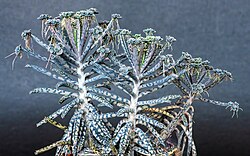Biology:Kalanchoe delagoensis
| Kalanchoe delagoensis | |
|---|---|

| |
| It is able to propagate vegetatively from plantlets that develop on its leaf margins. | |
| Scientific classification | |
| Kingdom: | Plantae |
| Clade: | Tracheophytes |
| Clade: | Angiosperms |
| Clade: | Eudicots |
| Order: | Saxifragales |
| Family: | Crassulaceae |
| Genus: | Kalanchoe |
| Species: | K. delagoensis
|
| Binomial name | |
| Kalanchoe delagoensis Eckl. & Zeyh.
| |
| Synonyms[2] | |
| |
Kalanchoe delagoensis, formerly known as Bryophyllum delagoense[1] and commonly called mother of millions or chandelier plant,[3] is a succulent plant native to Madagascar . Like other members of Bryophyllum (now included in Kalanchoe[2]), it is able to propagate vegetatively from plantlets that develop on its leaf margins.
Description
It is a robust, completely bare, biennial or more or less perennial, succulent plant that reaches heights of between 0.2 and 2 meters. The upright stems are simple and round. The three-seated, seemingly opposite or alternate leaves are usually upright to straight when spread out. They are slightly cylindrical, a little rutty on the top and reach a length of 1 to 13 centimeters with a diameter of 2 to 6 millimeters. The leaf blade narrowed at the base is reddish-green to gray-green with reddish brown spots. At the tip of the leaf margin there are two to nine small teeth on which there are numerous brood buds.
Inflorescences
The compact, multi-flowered inflorescences form thyrses 10 to 25 centimeters long. The slender flower stalk is between 6 and 20 millimeters long. The hermaphrodite flowers are hanging. The reddish to green and red-striped petals are fused together like a bell. The 2.5 to 6 millimeter long corolla tube ends in sharply pointed, triangular-lanceolate corolla lobes 5 to 10 millimeters long and 3.7 to 5.7 millimeters wide. The stamens are attached below the center of the corolla tube and do not protrude beyond the tube. The 2 to 2.5 millimeters large anthers are egg-shaped. The nectar flakes, 0.7 to 2 centimeters long are half-round to square with a rounded tip. The oval-elongated carpel is 5.5 to 6.5 millimeters long. The stylus has a length of about 2 millimeters.
The upright follicles contain seeds with a diameter of 0.6 to 2.5 millimeters.
Invasive species
This species' capability for vegetative reproduction, its drought tolerance, and its popularity as a garden plant, relate to this species' becoming an invasive weed in places such as eastern Australia, South Africa [4] and many Pacific islands. In the Neotropics hummingbirds sometimes pollinate this non-native plant.[5]
Kalanchoe delagoensis is unwelcome because it displaces native plants and contains bufadienolide cardiac glycosides[6] which can cause fatal poisoning, particularly in grazing animals like cattle.[7] During 1997, 125 head of cattle died after eating this species on a travelling stock reserve near Moree, NSW.[8]
In the Australian states of New South Wales[9] and Queensland,[10] this species and its hybrids have been declared a noxious weed.
See also
- List of poisonous plants
- Mother of thousands (disambiguation)
Footnotes
- ↑ 1.0 1.1 Rafter, M.A.; Gillions, R.M.; Walter, G.H. (2008). "Generalist herbivores in weed biological control—A natural experiment with a reportedly polyphagous thrips". Biological Control (Elsevier BV) 44 (2): 188–195. doi:10.1016/j.biocontrol.2007.09.011. ISSN 1049-9644.
- ↑ 2.0 2.1 "Kalanchoe delagoensis Eckl. & Zeyh.". Kew Science. http://powo.science.kew.org/taxon/urn:lsid:ipni.org:names:274320-1.
- ↑ {{citation | mode = cs1 | title = Kalanchoe delagoensis | work = Germplasm Resources Information Network (GRIN) | url = | publisher = [[Organization:Agricultural Research ServAgricultural Research Service (ARS), United States Department of Agriculture (USDA) | access-date = }}
- ↑ "Invasive Species South Africa, Chandelier plant". https://invasives.org.za/fact-sheet/?wpv_post_search&wpv-wpcf-scientific-name=Bryophyllum+delagoense+%28Crassulaceae%29.
- ↑ For example sapphire-spangled emerald (Amazilia lactea) in Brazil (Baza Mendonça & dos Anjos 2005)
- ↑ Bryotoxins A, B and C: McKenzie et al. (1987), Steyn & van Heerden (1998)
- ↑ McKenzie & Dunster (1986), McKenzie et al. (1987)
- ↑ les tanner. "North West Weeds". Northwestweeds.nsw.gov.au. Archived from the original on 2009-06-21. https://web.archive.org/web/20090621015741/http://northwestweeds.nsw.gov.au/mother_of_millions.htm. Retrieved 2013-02-19.
- ↑ "The New South Wales Government WeedWise Resource". https://weeds.dpi.nsw.gov.au/Weeds/MotherOfMillions.
- ↑ "The Queensland Government Resource on invasive plants". https://www.business.qld.gov.au/industries/farms-fishing-forestry/agriculture/land-management/health-pests-weeds-diseases/weeds-diseases/invasive-plants/restricted/mother-millions.
References
| Wikimedia Commons has media related to: |
- Baza Mendonça, Luciana & dos Anjos, Luiz (2005): Beija-flores (Aves, Trochilidae) e seus recursos florais em uma área urbana do Sul do Brasil [Hummingbirds (Aves, Trochilidae) and their flowers in an urban area of southern Brazil]. [Portuguese with English abstract] Revista Brasileira de Zoologia 22(1): 51–59. doi:10.1590/S0101-81752005000100007 PDF fulltext
- McKenzie, R.A. & Dunster, P.J. (1986): Hearts and flowers: Bryophyllum poisoning of cattle. Australian Veterinary Journal 63(7): 222-227. doi:10.1111/j.1751-0813.1986.tb03000.x PMID 3778371 (HTML abstract)
- McKenzie, R.A.; Franke, F.P. & Dunster, P.J. (1987): The toxicity to cattle and bufadienolide content of six Bryophyllum species. Australian Veterinary Journal 64(10): 298-301. doi:10.1111/j.1751-0813.1987.tb07330.x PMID 3439945 (HTML abstract)
- Steyn, Pieter S & van Heerden, Fanie R. (1998): Bufadienolides of plant and animal origin. Nat. Prod. Rep. 15(4): 397-413. doi:10.1039/a815397y PDF fulltext
Wikidata ☰ Q137831 entry
 |



